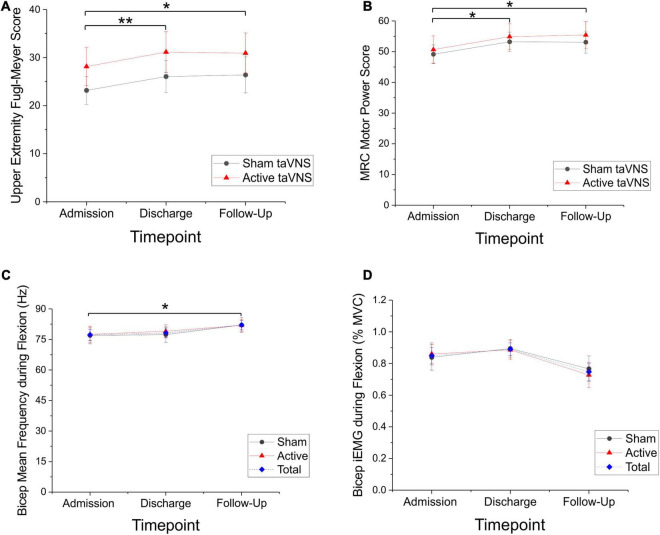FIGURE 2.
Significant motor improvements and significant changes in sEMG measures of bicep mean frequency were seen in both the active and sham taVNS groups, suggestive of a training benefit from the robot. (A) Upper Extremity Fugl Meyer scores (mean ± SEM) improved for both the sham (N = 15) and active (N = 14) taVNS groups, with a mean improvement of 3 points (Friedman RM-ANOVA, sham P < 0.001, Chi-square = 20.920; active P < 0.001, Chi-square = 16.453). Improvements were significant at discharge and robust through follow-up (Tukey test, sham and active: adm-dc **P < 0.001, adm-fu *P < 0.01). (B) MRC motor power scores (mean ± SEM) were also improved for both the sham (N = 15) and active (N = 14) groups (Friedman RM-ANOVA, sham P < 0.01, Chi-square = 13.0; active P < 0.001, Chi-square = 15.434). These improvements were significant at discharge and robust through follow-up (Tukey test, active and sham: adm-dc *P ≤ 0.01; sham: adm-fu *P < 0.05, active adm-fu *P < 0.001). (C) Directional trends for sEMG are significant for both summed sham and active groups (mean ± SEM; N = 28; blue dashed line). Mean frequency of the biceps during flexion significantly increased across the combined group (One-way RM-ANOVA, P < 0.05, F = 3.274), between admission and follow-up (Tukey test, *P < 0.05). (D) Biceps iEMG (area under the RMS curve) during flexion approached a significant reduction (in% mean voluntary contraction) across the combined group (One-way RM-ANOVA, P = 0.050).

